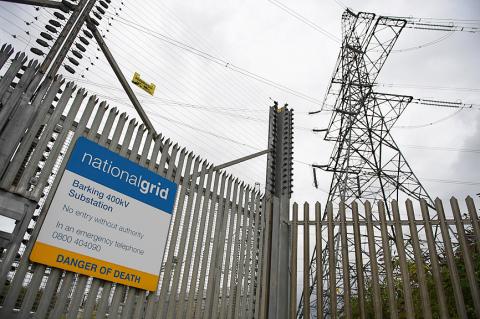National Grid PLC is to investigate how to better incorporate the UK’s increasing share of renewable energy in the power mix after a blackout earlier this month saw more than 1 million homes lose power.
The probe was sparked by the Aug. 9 blackout that also caused havoc on the transport networks, after a lightening strike north of London led to Orsted A/S’s giant Hornsea One offshore wind farm failing at about the same time as RWE AG’s Little Barford gas plant.
Renewable energy, which is mainly intermittent, accounted for one-third of the UK’s power last year.

Photo: AFP
The blackout came at a time when the UK’s power industry is facing increased political scrutiny.
The opposition Labour Party has promised to renationalize some parts of the network if it wins the next general election, and the government is concentrating on leaving the EU, which would upend trade ties and the case for badly needed investment in the nation’s energy infrastructure.
“The evolution of the electricity generation mix in Great Britain since 2008 has been significant,” National Grid said in its preliminary report to the British Office of Gas and Electricity Markets (Ofgem). “Wind generation, solar and interconnectors are different to the conventional electricity generation sources.”
The sudden shutdowns resulted in as much as 1.3 gigawatts suddenly going offline, National Grid said in a preliminary report to Ofgem published yesterday.
That is about the size of a modern nuclear reactor.
The grid was restored within a few minutes with backup sources as 1.1 million households were without power for as long as 50 minutes, but train networks were thrown into disarray during the Friday evening rush hour, leaving commuters stranded.
Ofgem would also probe whether National Grid held sufficient backup generation, and whether RWE and Orsted breached their legal obligations to the grid, it said.
“We believe there are still areas where we need to use our statutory powers to investigate these outages,” Ofgem Executive Director of Systems and Networks Jonathan Brearley said.
A final, detailed technical report by the grid must be delivered to the regulator by Sept. 6, Ofgem said.
National Grid said in its report that it welcomed the move to commission the government’s Energy Emergencies Executive Committee to review the incident.
National Grid plans to develop new frequency response services and inertia monitoring systems to help stabilize the grid.
Orsted’s Hornsea One is the world’s largest offshore wind farm.

SETBACK: Apple’s India iPhone push has been disrupted after Foxconn recalled hundreds of Chinese engineers, amid Beijing’s attempts to curb tech transfers Apple Inc assembly partner Hon Hai Precision Industry Co (鴻海精密), also known internationally as Foxconn Technology Group (富士康科技集團), has recalled about 300 Chinese engineers from a factory in India, the latest setback for the iPhone maker’s push to rapidly expand in the country. The extraction of Chinese workers from the factory of Yuzhan Technology (India) Private Ltd, a Hon Hai component unit, in southern Tamil Nadu state, is the second such move in a few months. The company has started flying in Taiwanese engineers to replace staff leaving, people familiar with the matter said, asking not to be named, as the

The prices of gasoline and diesel at domestic fuel stations are to rise NT$0.1 and NT$0.4 per liter this week respectively, after international crude oil prices rose last week, CPC Corp, Taiwan (台灣中油) and Formosa Petrochemical Corp (台塑石化) announced yesterday. Effective today, gasoline prices at CPC and Formosa stations are to rise to NT$27.3, NT$28.8 and NT$30.8 per liter for 92, 95 and 98-octane unleaded gasoline respectively, the companies said in separate statements. The price of premium diesel is to rise to NT$26.2 per liter at CPC stations and NT$26 at Formosa pumps, they said. The announcements came after international crude oil prices

DOLLAR SIGNS: The central bank rejected claims that the NT dollar had appreciated 10 percentage points more than the yen or the won against the greenback The New Taiwan dollar yesterday fell for a sixth day to its weakest level in three months, driven by equity-related outflows and reactions to an economics official’s exchange rate remarks. The NT dollar slid NT$0.197, or 0.65 percent, to close at NT$30.505 per US dollar, central bank data showed. The local currency has depreciated 1.97 percent so far this month, ranking as the weakest performer among Asian currencies. Dealers attributed the retreat to foreign investors wiring capital gains and dividends abroad after taking profit in local shares. They also pointed to reports that Washington might consider taking equity stakes in chipmakers, including Taiwan Semiconductor

A German company is putting used electric vehicle batteries to new use by stacking them into fridge-size units that homes and businesses can use to store their excess solar and wind energy. This week, the company Voltfang — which means “catching volts” — opened its first industrial site in Aachen, Germany, near the Belgian and Dutch borders. With about 100 staff, Voltfang says it is the biggest facility of its kind in Europe in the budding sector of refurbishing lithium-ion batteries. Its CEO David Oudsandji hopes it would help Europe’s biggest economy ween itself off fossil fuels and increasingly rely on climate-friendly renewables. While